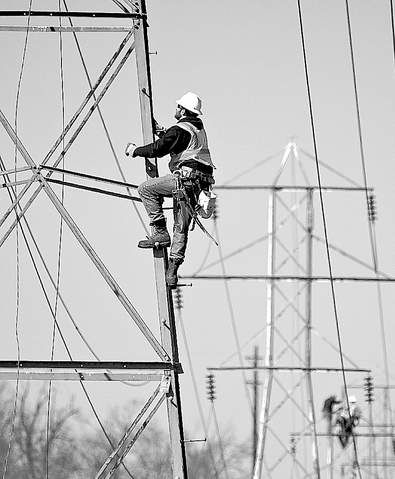With some rural towns still cut off, Kentucky keeps talking – creatively
Published 4:00 am Saturday, February 7, 2009

- Utility workers climb towers to make repairs in Free Union, Ky. Thousands of area residents are still without power 11 days since a crippling ice storm. In addition to power losses, landline phones were down and some cell phone companies had to switch to generators.
MURRAY, Ky. — When an ice storm brought down telephone poles and power lines across much of Kentucky, one small-town mayor pulled out his iPhone and began tapping away, posting rapid-fire updates on Facebook to let his constituents know what was going on.
“Will is glad to report that power in parts of the South Main and Grapevine areas is back on. Slowly but surely …,” Madisonville Mayor William Cox typed.
Days later, he warned: “Will asks people with frozen water meters to PLEASE not use a torch or build a fire inside the meter box. This WILL damage the cutoff and meter!”
And at another point, he offered this piece of news: “Will was just advised by the Hopkins County School System that there is NO school on Monday or Tuesday.”
The killer storm last week forced many people in Kentucky to get creative just to communicate.
‘Started typing’
In a rural community 40 miles from Madisonville, a couple used their truck’s OnStar service to summon help when fallen trees blocked the road leading from their trailer. And in Murray, a college radio station managed to stay on the air with the help of a generator, giving people vital information on where to find food and heat.
“I wish I could say I had some great epiphany I was going to use this to communicate with my citizens, but I didn’t,” said Cox, who charged his iPhone in his car to keep his messages flowing. “I just got my phone out and started typing, and I haven’t stopped.”
At the height of the ice storm, more than 1.3 million homes and businesses were left without power in several states, and thousands still don’t have it back. The storm knocked out landline phones and forced some cell phone companies onto backup generators. In many cases, wireless Internet worked when cell phones didn’t get through.
Virtual meeting
Though his town’s 19,000 residents were staying in shelters, bunking with relatives or cut off from neighbors because they had no power, Cox managed to create a virtual town hall meeting with his iPhone.
He sent out a blizzard of Facebook messages updating townspeople on efforts to restore power, water and other services, and they responded with questions and encouragement.
On Friday, a week and a half after the storm, he was still cranking out updates, among them:
•“Will has been told that additional Kenergy crews are supposed to arrive today.”
•“Will advises that tree crews will be in the following areas today: McPherson/Parkwood, Highland Drive, and Dodson Lane.”
•“Will estimates that 90% of City utility customers are back online.”
The communication challenges also stymied people trying to get emergency help. Where there were no working phones, there was no way to call 911. Though National Guardsmen made door-to-door safety checks, they couldn’t be everywhere at once.
Brian Murphy, 58, was trapped at his rural Caldwell County home with his wife, who suffers from multiple sclerosis and is blind. With the roads blocked, they waited and waited for help, but no one came. Their food supply had dwindled to crackers and peanut butter.
Murphy was able to cut a path in his driveway, reached his truck and used its OnStar emergency road-service system to contact his sister, Kathy McElroy. She, in turn, called emergency workers.
He stayed in contact with her via OnStar for two days until a crew used chain saws to cut their way through to the Murphys. The couple were finally able to drive to his sister’s home.
“I was just thrilled,” McElroy said, her voice shaking. “Everything is good.”






